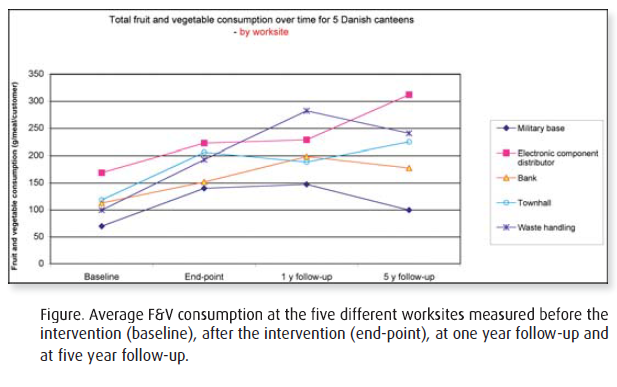Long term sustainability of a worksite canteen intervention of serving more F&V
Sustainability of an intervention
The sustainability of interventions is found to be a central challenge in public health promotion not only related to the worksite setting, but in health promotion in general. Many health interventions fail to consider the interventions as complex systems that interact dynamically with the key stakeholders, the setting and the broader community. Therefore the aim of the present study was to analyze the five years sustainability of a worksite canteen intervention of serving more fruit and vegetables (F&V)1,2.
Study design
The F&V consumption (g/meal/day per customer) from five worksite canteens were measured five years after the intervention started and compared to the F&V consumption at baseline, end-point, and four months after the intervention ended (one year follow-up).
The intervention used a participatory and empowering approach, selfmonitoring and networking among the canteen staff, management and a consultant. The method focused on providing ideas for increased F&V for lunch, making environmental changes in the canteens by giving access to tasteful and healthy food choices and reducing availability of unhealthy options. The worksites served from 50 to 500 meals a day.
Sustainability of the F&V worksite intervention
The figure below shows the average F&V consumption per Customer over time for each of the five worksites. The figure also shows the differences in F&V consumption at the baseline, the end-point and the one year follow-up compared to the five year follow-up. Overall, a net average increase of 95g F&V per customer per day was achieved from baseline to the five year follow-up measurements for the five worksites.
Figure. Average F&V consumption at the five different worksites measured before the intervention (baseline), after the intervention (end-point), at one year follow-up and at five year follow-up.
At the military base an insignificant increase of 18g per customer per day compared to the baseline was seen (p=0.28) at the five year follow-up measurements. The other four worksites all increased the F&V consumption significantly from baseline to the five year follow-up measurements (p<0.001). One of these four worksites further increased significantly (p<0.001) its F&V consumption from both the end-point and the one year follow-up to the five year follow-up measurements (the electronic component distributor).
Barriers and enhances towards changes
Organizations may vary in the extent to which the pre-existing structures and processes are able to facilitate organizational change to promote health3. Therefore it is crucial to identify and address barriers to and enhance facilitators of organizational and environmental changes within worksites4.

In order to find the success factors related to sustaining an F&V intervention and to understand why some healthy eating interventions are sustained better than others we carried out 21 semistructured interviews at the five worksites5. The analysis of these semi-structured interviews provides insight into the co-shaping of the intervention and the organization in which the intervention takes place6. A number of themes showed to be important; contracting out the food service may challenge the sustainability but may also be a way of ensuring the necessary competences for a more F&V intensive food supply. Structural changes of the worksite, like re-structuring, may also challenge the sustainability if this implies frequent changes of worksite employees and new employees question the F&V intensive food supply. The engagement of the canteen manager and the ability to develop strategies for integration of more F&V in the food supply and good cooperation with the F&V suppliers also play a crucial role.
Tailored intervention in partnership with local stakeholders
The results of this study indicate that a worksite intervention needs to be tailored to the needs of the particular worksite environment in which it is implemented. Furthermore this tailoring needs to be done in close partnership with the local stakeholders. The results also indicate that worksite canteens are important change agents – intermediaries for developing intervention components. Healthier eating interventions are shaped and controlled by the involved local actors’ ideas of health and nutrition and also by their concepts of how these ideas interrelate with the worksite’s working conditions and working performance.
References
- Lassen A, Thorsen AV, Trolle E, Elsig M & Ovesen L. Successful strategies to increase the consumption of fruits and vegetables: results from the Danish ‘6 a day’ Work-site Canteen Model Study. Public Health Nutr. 2004; 7, 263-270.
- Thorsen AV, Lassen A, Tetens I, Hels O & Mikkelsen BE, (2010) Long term sustainability of a worksite canteen intervention of serving more Fruit and Vegetables. Public Health Nutr. 2010; 13: 1647 – 52
- Dooris M. Healthy settings: challenges to generating evidence of effectiveness. Health Promot. Int. 2006; 21, 55-65.
- Sorensen G, Linnan L, Hunt MK (2004) Worksite-based research and initiatives to increase fruit and vegetable consumption. Prev Med 39, Suppl. 2, 94–100.
- Kvale S, (1996) InterViews: An Introduction to Qualitative Research Interviewing. London: SAGE Publications.
